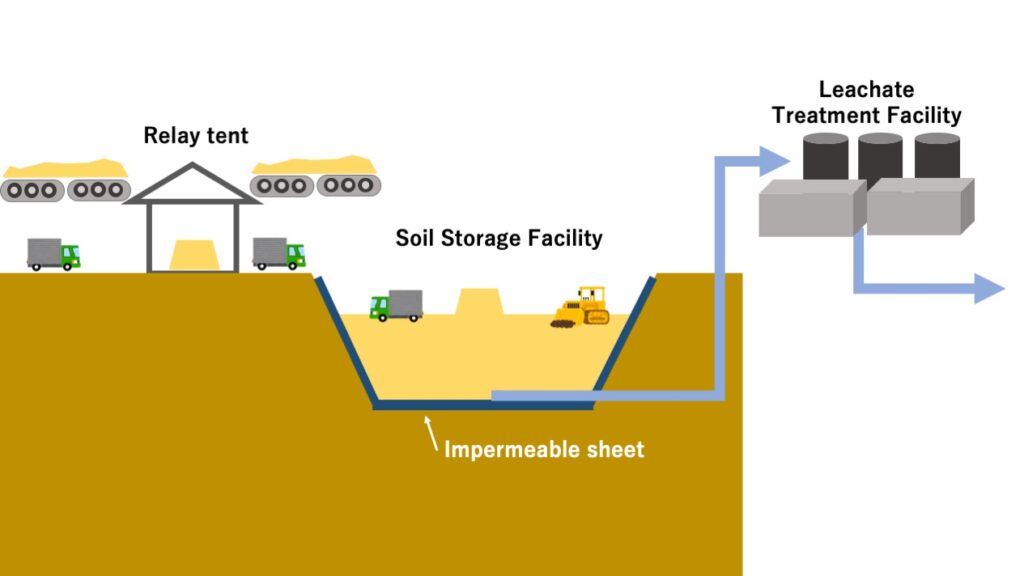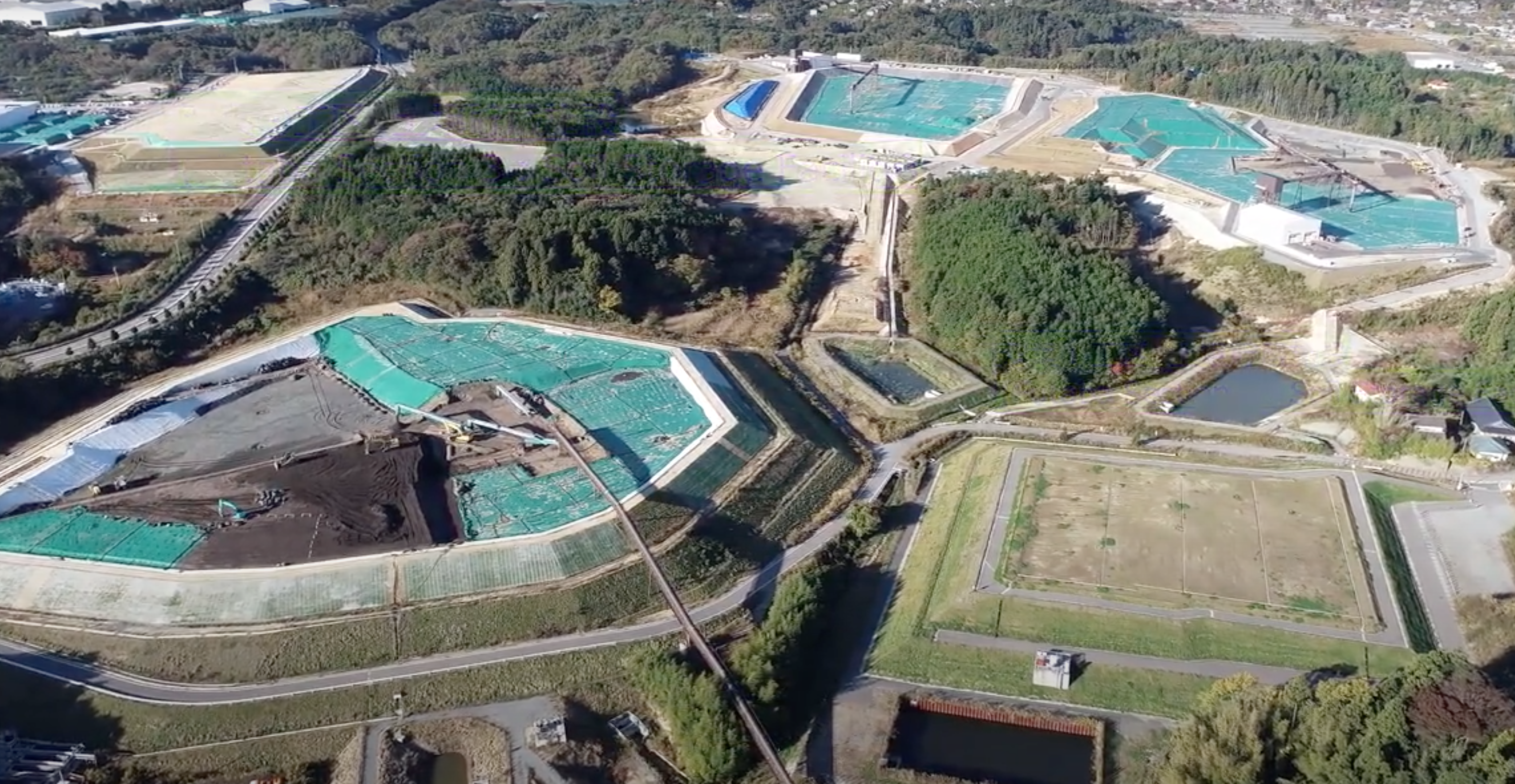Reference: Interim Storage Facility Information Center (The Storage Facilities in the Futaba Construction Section No.1 – No.3)
Hello, everyone. My name is Daichi, an expert providing the information on the radiation issues in an easy-to-understand manner.
The previous article mainly covers the overview of the Interim Storage Facility, including kinds of stored soil and waste, location and size of the Interim Storage Facility as well as kinds of constructed facilities.
As a continuous article from the previous, this article covers treatment procedures of soil and waste transported into the Interim Storage Facility, followed by explanation of the 2 following facilities, which play an important role in the Interim Storage Facility.
– Soil Separation Facility
– Soil Storage Facility
In other words, this article will response to the following questions:
– How are soil and waste treated in the Interim Storage Facility?
– What is the Soil Separation Facility?
– What is the Soil Storage Facility?
Table of contents of this article
- (Let’s learn the Soil Separation/Storage Facility) What is the Interim Storage Facility? (Vol. 2)
- Procedures for treatment of soil and waste in the Interim Storage Facility
- The Soil Separation Facility
- Unloading
- Tearing bags
- Separation
- Transportation
- The Soil Storage Facility
- Summary
I have been involved with the radiation-relevant issues, like the policy on the decontamination activities and the management of the Interim Storage Facility, after the accident of the Fukushima Daiichi Nuclear Power Plant in 2011.
I received a doctorate in the field of radiation, while working in Fukushima.
(Let’s learn the Soil Separation/Storage Facility) What is the Interim Storage Facility? (Vol. 2)
In the previous article, basic role as well as major facilities in the premise of the Interim Storage Facility are explained.
This article begins with explanation of treatment procedures of soil and waste transported into the Interim Storage Facility, followed by further explanation more in detail regarding the important and major facilities: the Soil Separation Facility and the Soil Storage Facility.
Procedures for treatment of soil and waste in the Interim Storage Facility

As explained in the previous article, soil and waste arising from decontamination activities in Fukushima Prefecture are transported into the Interim Storage Facility.
There are other procedures, but major procedures are represented in the above figure.
From the temporary storage sites (please visit this article and this article) outside the premise, soil and waste arising from the decontamination activities are transported into the Interim Storage Facility.
And part of the burnables are transported into the Interim Storage Facility as ash, after being incinerated in the Temporary Incineration Facility outside the Interim Storage Facility.
The soil, burnables as well as ash are temporarily stored in the Storage Sites till next procedures when necessary.
Details will be covered in the following parts, but of these soil and waste, removed soil is transported into the Soil Separation Facility to remove big stones and burnables, and only soil with small diameter is transported into the Soil Storage Facility.
Part of the burnables like grass and woods arising from decontamination activities are, as aforementioned, incinerated in the Temporary Incineration Facility outside the premise before transported into the Interim Storage Facility, but rest of them are incinerated in the Temporary Incineration Facility in the premise.
Burnables generated in the above-mentioned Soil Separation Facility are also transported into the Temporary Incineration Facility and incinerated.
Details are elaborated in this article, but ash generated in the Temporary Incineration Facilities both in and outside the Interim Storage Facility is treated in the Temporary Ash Treatment Facilities adjacent to the Temporary Incineration Facilities.
Slags and metals are collected from the Temporary Ash Treatment Facilities for the future recycling.
This is also explained in this article, but fly ash generated in the Temporary Ash Treatment Facilities is supposed to be stored in the Waste Storage Facility for a long time till further treatment in the future.
The Soil Separation Facility

The above figure briefly represents the treatment procedures of removed soil in the Soil Separation Facility.
For the recycling in the future, there are 2 kinds of Soil Separation Facility: one for removed soil with radioactivity concentration of more than 8,000Bq/kg, and the other for that of 8,000Bq/kg or less.
By the way, there were at maximum 9 Soil Separation Facility in the premise of the Interim Storage Facility, but of the 9 facilities, 4 will be dismantled by end of March 2023.
There are some differences between operators which manage the facilities, but basic treatment procedures in the Soil Separation Facility are as shown in the above figure, specifically consisting of 4 procedures: Unloading, Tearing bags, Separation and Transportation.
Each procedure will be elaborated in the following chapters.
Unloading
Here container bags with removed soil and waste transported by trucks are unloaded onto a conveyor belt.
When trucks transport removed soil and waste into the premise of the Interim Storage Facility, they are covered with sheets, so they are uncovered here and container bags are unloaded one by one.
Tearing bags
Container bags unloaded onto the conveyor belt are transported into the Soil Separation Facility.
As its name represents, in this procedure, the container bags are torn to take removed soil out of them.
Methodologies to tear the bags depend on each JV (Joint Venture), which operate the facilities: for example, high pressure water, wire and crushing machine with double axes are used.
Removed soil taken out of the container bags are transported into the separation procedure covered below.
Separation
In the Separation procedure, the removed soil is treated with sieves twice.
Methodologies for sieving are also different between operators (JV), but in every Soil Separation Facility, during the first sieving procedure, foreign materials (e.g. big stones) with diameter of more than 10cm are removed.
During the second sieving procedure, foreign materials with diameter of 2cm are removed, but before that, modifier is added.
The modifier is added to improve the characteristics of soil, to make the second sieving procedure more effective.
Sometimes there is soil with high moisture and viscous soil, that make sieving procedure difficult, so modifier is added for more effective sieving, by making the soil drier.
After these procedures, only soil with diameter of less than 2cm is transported to the Soil Storage Facility.
Transportation
Treated soil after 2 sieving processes is transported from the Soil Separation Facility into the Soil Storage Facility.
There are 2 specific methods for the transportation: conveyor belts or trucks, taking account of geological circumstances between the Soil Separation Facility and the Soil Storage Facility, as well as progress of construction.
The Soil Storage Facility

The soil transported from the Interim Separation Facility is first unloaded in the Relay Tent.
The Relay Tent plays its role as like so-called ‘buffer’, and it can store a certain amount of soil for a certain period of time treated in the Soil Separation Facility, even if no operation can be done in the Soil Storage Facility under the bad weather condition.
From the Relay Tent, the treated soil is transported by conveyor belt, if the treated soil has more than 8,000Bq/kg of radioactivity of radioactive concentration.
If the radioactivity concentration is 8,000Bq/kg or less, it is transported to the Soil Storage Facility by trucks.
In the Soil Storage Facility, the treated soil is stored by leveling and pressing by heavy machines like bulldozers.
At the bottom of the Soil Storage Facility impermeable sheets are laid to prevent rainwater falling on the Soil Storage Facility from penetrating into the underground.
The rainfall on the Soil Storage Facility is collected into the Leachate Treatment Facility using water collection facilities, and it is supposed to be released into the environment, after the necessary water treatment and monitoring of radioactivity concentration.
Summary
This article covers procedures of removed soil in the Interim Storage Facility, as well as individual facility, including the Soil Separation Facility and the Soil Storage Facility.
By the way, above-mentioned contents are summarized in the following videos.
It would be appreciated to visit them at your convenience.
– Japanese version
– English version
You can read the same article in Japanese here.
Thank you very much for reading this article.
See you next time!



コメント